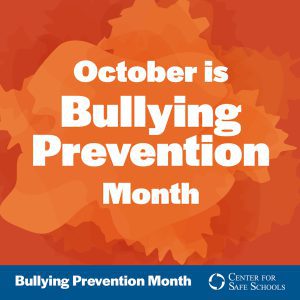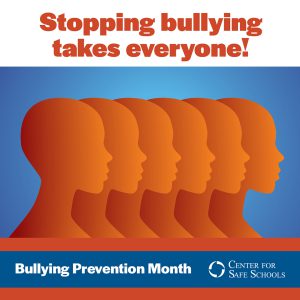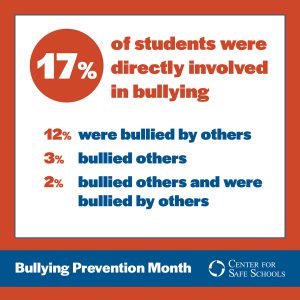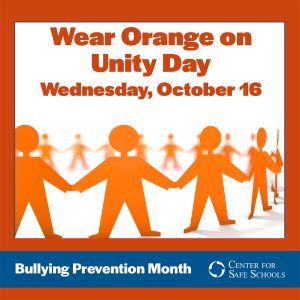October is National Bullying Prevention Month
Every October is National Bullying Prevention Month, a time to raise awareness, educate, and inspire action to build a world without bullying. But our work doesn’t end in October; fostering a safe, inclusive environment is a year-round commitment. Let’s continue to work together to prevent bullying, promote kindness, and strengthen our communities every day.
Use and Share Our Digital Content
Please use our digital tools below to raise awareness of ways to prevent bullying in your schools and communities.
Use our hashtags
- #BullyingPreventionMonth
- #BullyingPreventionMonthPA
- #WearOrangeForBullyingPrevention
- #UnityEveryDay
Tag us in your posts
- Facebook: Center for Safe Schools
- Instagram: @ctrsafeschools
- LinkedIn: Center for Safe Schools
Sample Social Post Content
#Parents: You may not see bullying happen, but you may be the first to become aware of it. If you think your child is being bullied, explain to them that bullying is wrong, and it is not their fault. More tips at https://bit.ly/CSS-BP #BullyingPreventionMonthPA
#Parents: Help support #BullyingPrevention. Educate yourself about what bullying is and is not. Learn your school’s policy on bullying. Support school’s messages against bullying. Talk to your child about the school’s policies. https://bit.ly/CSS-BP #BullyingPreventionMonthPA
Help get kids involved in #Antibullying by using the PACER #BullyingPreventionMonth toolkit. https://www.pacer.org/bullying/nbpm/activity-kit/activity-kit.asp #BullyingPreventionMonthPA
Bullying is when someone repeatedly and on purpose says or does mean or hurtful things to another person who has a hard time defending himself or herself. Learn more at https://bit.ly/CSS-BP #BullyingPreventionMonthPA
Studies indicated that young victims of bullying have higher rates of agoraphobia, depression, anxiety, panic disorder and suicidality in their early to mid‐20s, compared to those who have not been bullied in childhood https://bit.ly/CSS-BP #BullyingPreventionMonthPA
Racial and ethnic minority youth and immigrants are more likely than majority and native-born youth to experience bias-based bullying. https://bit.ly/CSS-BP #BullyingPreventionMonthPA
ALWAYS report bullying to a trusted adult at school and at home. Also, schools in Pennsylvania have Safe2Say 1-844SAF2SAY or 1-844-723-2729. #BullyingPreventionMonthPA https://www.safe2saypa.org/
We wear orange on Unity Day October 16 to show we believe all students should be free to be who they are without bullying. Find out why we wear the color orange in this video. Show us your staff or students rocking orange today! #UnityEveryDay https://youtu.be/8gKBQEQUW5g
More than 1 of every 5 students report being bullied. Take action at school, at home, in your neighborhood,
at a local business, or in your workplace to show that you care about kids being safe at school, online, and in the community. https://bit.ly/CSS-BP #bullyingpreventionmonthPA
Bullying affects a student’s ability to learn. Students who are bullied often do not want to go to school, find it difficult to concentrate, show a decline in grades, and lose self-esteem. Learn how you can help prevent bullying. #bullyingpreventionmonthPA https://bit.ly/CSS-BP
Kids who witness bullying are more likely to have increased use of tobacco, alcohol, or other drugs; have increased mental health problems; and miss school. Talk to your kids about what they can do if they witness bullying. #bullyingpreventionmonthPA https://bit.ly/CSS-BP
Social Art
Download the images below to use in your posts and emails. To download, please click on the thumbnail and right-click “save image as” to save the image to your device.




You can also visit the PACER National Bullying Prevention Month Toolkit for more social graphics and sample posts.
Key Facts and Statistics
Statistics from the 2018 Indicators of School Crime and Safety – PDF show that only 20% of school bullying incidents were reported. (Source: stopbullying.gov)
The 2019 School Crime Supplement to the National Crime Victimization Survey (National Center for Education Statistics and Bureau of Justice) indicates that, nationwide, about 22% of students ages 12–18 experienced bullying. (Source: stopbullying.gov)
The 2021 Youth Risk Behavior Surveillance System(Centers for Disease Control and Prevention) indicates that, nationwide, 15.0% of students in grades 9–12 report being bullied on school property in the 12 months preceding the survey. (Source: stopbullying.gov)
The The Youth Risk Behavior Survey Data Summary & Trends Report provides data on health behaviors and experiences of high school students in the United States. Data highlight students’ behaviors and experiences in 2023, changes from 2021 to 2023, and 10-year trends. (Source: U.S. Centers for Disease Control and Prevention)